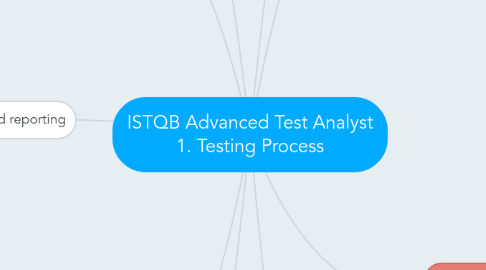
1. Implementation
1.1. Activities
1.1.1. creating automated tests
1.1.2. finalizing test data and test environments
1.1.2.1. environment(s) should be fully set up and verified prior to test execution
1.1.2.2. create data to be used with data-driven automation tests as well as for manual testing
1.1.2.3. create input and environment data to load
1.1.3. organizing tests (both manual and automated) into execution order
1.1.4. forming a test execution schedule, including resource allocation
2. Execution
2.1. begins once the test object is delivered and the entry criteria to test execution are satisfied
2.2. Combine scripted and unscripted (e.g., exploratory) testing techniques
2.3. In some cases, users or customers may participate in test execution
2.4. Specific areas to consider
2.4.1. Notice and explore “irrelevant” oddities
2.4.2. Check that the product is not doing what it is not supposed to do
2.4.3. Take notes for the next testing effort
2.4.4. Do not expect to rerun all manual tests
2.4.5. Consider creating test cases for defects and add them to the regression test suite
2.4.6. Find the defects before regression testing
3. Evaluating exit criteria and reporting
3.1. Exit criteria are defined in the planning stages
3.2. Consider "must” and “should” criteria
3.3. Test Analyst is responsible for supplying the information that is used by the Test Manager to evaluate progress toward meeting the exit criteria and for ensuring that the data is accurate
3.4. Additional activities
3.4.1. Provide status report during the testing cycles
3.4.2. Contribute to the final report at the end of the testing
3.4.2.1. require gathering metrics from the defect and test management systems
3.4.2.2. assessing the overall coverage and progress
4. Test closure activities
4.1. Key outputs from the testing effort should be captured and either passed to the relevant person or archived
4.2. Test Analyst should also think about what information would be needed if the project were to be started up again at a future time
4.3. TA involved in delivering work products
4.3.1. known defects should be communicated to support team
4.3.2. Tests and test environments passed for maintenance team
4.3.3. Pass regression test set (either automated or manual)
4.3.4. Work product information must be clearly documented
4.4. TA can participate in retrospective meeting
4.5. TA archive results, logs, reports in the configuration management system
5. Determining the right tests and test cases, designing them and executing them are the primary areas of concentration for the Test Analyst.
6. Planning, monitoring and control
6.1. Test Planning
6.1.1. Test Analyst is working with the Test Manager
6.1.2. All types of testing should be considered in the test plan and scheduled accordingly
6.1.3. Review the test estimates with the Test Manager
6.1.4. Plan for configuration testing
6.1.5. Plan to test the documentation
6.1.6. Plan to test the installation procedures
6.1.7. Allow adequate time for identifying and analyzing risks with the cross-functional team. TA not responsible, but actively involved
6.2. Test Monitoring and Control
6.2.1. It is usually the job of the Test Manager
6.2.2. Test Analyst contributes to the measurements that make the control possible
7. Analysis
7.1. Entry criteria
7.1.1. test basis available
7.1.2. test basis passed review
7.1.3. reasonable budget and schedule available
7.2. Tasks
7.2.1. Analyze the test basis
7.2.2. Identify the test conditions
8. Design
8.1. Entry criteria
8.1.1. availability of tools that will be used during the design work
8.2. Activities
8.2.1. Determine in which test areas low-level (concrete) or high-level (logical) test cases are most appropriate
8.2.2. Determine the test case design technique(s) that provide the necessary test coverage
8.2.3. Create test cases that exercise the identified test conditions
8.3. Test Case Creation
8.3.1. The pass/fail criteria should be clearly identified
8.3.2. TC is designed to be understandable by other testers and stakeholders
8.3.3. TC should cover all the interactions of the software with the actors
8.4. Concrete Test Cases
8.4.1. Useful when...
8.4.1.1. testing staff is less experienced
8.4.1.2. requirements are well-defined
8.4.1.3. external verification of the tests, such as audits, is required
8.4.2. Pros
8.4.2.1. excellent reproducibility
8.4.3. Cons
8.4.3.1. may also require a significant amount of maintenance effort
8.4.3.2. tend to limit tester ingenuity during execution
8.5. Logical Test Cases
8.5.1. provide guidelines for what should be tested and allow to vary the actual data or even the procedure
8.5.2. may be used to develop concrete test cases when the requirements become more defined and stable
8.5.3. Cons
8.5.3.1. loss in reproducibility
8.5.4. Useful when...
8.5.4.1. requirements are not well-defined
8.5.4.2. testing staff is experienced with both testing and the product
8.5.4.3. when formal documentation is not required
8.5.4.4. may provide better coverage because they will vary somewhat each time
9. Keywords
9.1. test bases
9.1.1. Requirements
9.1.2. Functional design
9.1.3. Technical design
9.1.4. User manual
9.1.5. Use cases
9.1.6. Source code
9.1.7. Business experts
